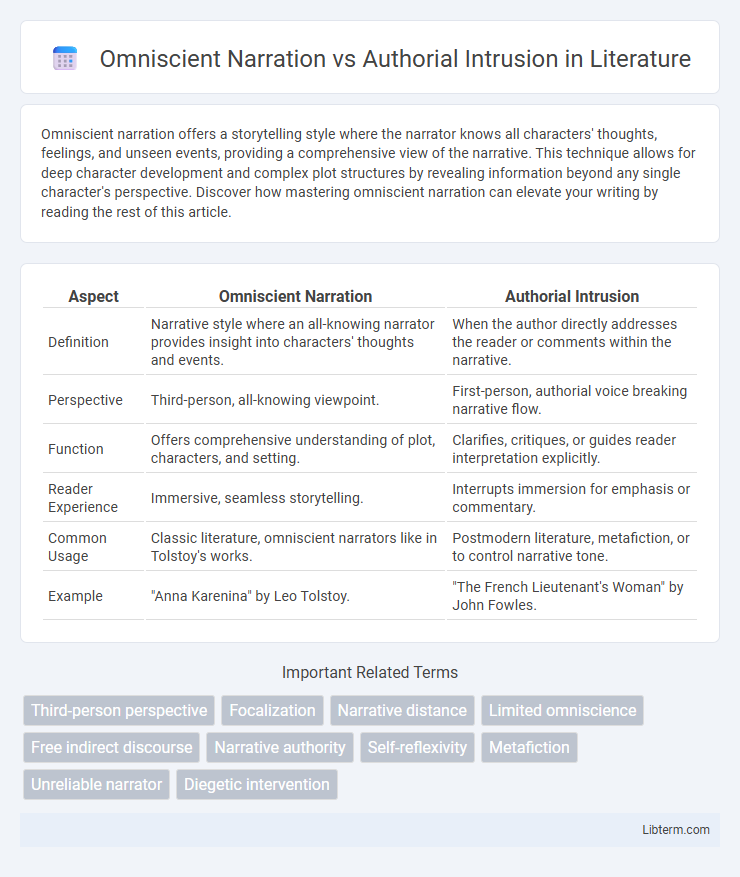Omniscient narration offers a storytelling style where the narrator knows all characters' thoughts, feelings, and unseen events, providing a comprehensive view of the narrative. This technique allows for deep character development and complex plot structures by revealing information beyond any single character's perspective. Discover how mastering omniscient narration can elevate your writing by reading the rest of this article.
Table of Comparison
| Aspect | Omniscient Narration | Authorial Intrusion |
|---|---|---|
| Definition | Narrative style where an all-knowing narrator provides insight into characters' thoughts and events. | When the author directly addresses the reader or comments within the narrative. |
| Perspective | Third-person, all-knowing viewpoint. | First-person, authorial voice breaking narrative flow. |
| Function | Offers comprehensive understanding of plot, characters, and setting. | Clarifies, critiques, or guides reader interpretation explicitly. |
| Reader Experience | Immersive, seamless storytelling. | Interrupts immersion for emphasis or commentary. |
| Common Usage | Classic literature, omniscient narrators like in Tolstoy's works. | Postmodern literature, metafiction, or to control narrative tone. |
| Example | "Anna Karenina" by Leo Tolstoy. | "The French Lieutenant's Woman" by John Fowles. |
What Is Omniscient Narration?
Omniscient narration is a narrative technique where the narrator possesses complete knowledge of all characters' thoughts, feelings, and events within the story, providing a comprehensive and all-seeing perspective. This narrative voice can move freely through time and space, offering insights that individual characters may not have. Unlike authorial intrusion, which directly interrupts the story with the author's personal commentary, omniscient narration maintains an immersive narrative flow without explicit authorial presence.
Defining Authorial Intrusion
Authorial intrusion occurs when the narrator directly addresses the reader, breaking the story's immersive flow to provide commentary, opinion, or moral judgment. This technique contrasts with omniscient narration, where the narrator maintains an all-knowing perspective without overtly inserting personal interjections. Defining authorial intrusion highlights its role as a deliberate narrative choice that disrupts the fictional world to engage the audience on a meta-textual level.
Key Differences Between the Two Techniques
Omniscient narration provides a comprehensive perspective where the narrator knows all characters' thoughts, feelings, and backgrounds, maintaining consistent narrative authority without direct commentary. Authorial intrusion breaks this narrative neutrality by having the author directly address the reader, offering personal opinions or insights that disrupt the story's flow. The key difference lies in omniscient narration's seamless all-knowing viewpoint versus authorial intrusion's explicit, subjective interjection from the author.
Historical Evolution in Literature
Omniscient narration evolved from classical oral storytelling traditions, where the narrator possessed unlimited knowledge, guiding readers through all characters' thoughts and events across timeframes. Authorial intrusion became prominent during the Renaissance, as writers like Geoffrey Chaucer and later 18th-century novelists inserted personal commentary to shape moral or thematic interpretations. The historical shift reflects changing literary tastes and the tension between immersive narrative and explicit authorial presence in shaping reader experience.
Narrative Voice and Perspective
Omniscient narration offers a comprehensive narrative voice that reveals the thoughts, feelings, and motivations of multiple characters, providing an all-knowing perspective that shapes the story's depth and complexity. Authorial intrusion interrupts the narrative with the author's direct commentary or opinions, breaking the immersive experience and shifting the perspective from the characters to the author's voice. The key distinction lies in omniscient narration's seamless and expansive viewpoint versus authorial intrusion's subjective interjections that influence the reader's interpretation.
Advantages of Omniscient Narration
Omniscient narration provides a comprehensive perspective by revealing the thoughts and motivations of multiple characters, enriching the reader's understanding of the plot and character dynamics. This narrative style allows seamless transitions across different settings and times, enhancing the story's depth and complexity. Unlike authorial intrusion, omniscient narration maintains narrative flow without breaking the story's illusion, offering an immersive and continuous reading experience.
Impact of Authorial Intrusion on Readers
Authorial intrusion disrupts the immersive experience by directly inserting the narrator's voice, creating a conscious awareness of the storytelling process. This technique can generate a sense of intimacy or authority, influencing readers' trust and engagement with the narrative. The impact varies, as some readers appreciate the unique perspective while others find it detracts from character-driven immersion.
Notable Literary Examples
Omniscient narration is exemplified in Leo Tolstoy's "War and Peace," where the narrator provides comprehensive insight into multiple characters' thoughts and events. Authorial intrusion appears prominently in Jane Austen's "Northanger Abbey," where the narrator directly addresses the reader with commentary. Both techniques shape the reader's engagement, with omniscient narration offering a panoramic understanding and authorial intrusion fostering a conversational connection.
Modern Trends and Usage
Modern trends in omniscient narration emphasize a seamless, immersive perspective that subtly guides readers through multiple viewpoints without overt authorial commentary. Authorial intrusion, once a common device for direct commentary, has diminished in contemporary fiction as writers favor showing over telling to preserve narrative immersion. This shift aligns with reader preferences for authenticity and complex character development, where the narrator's presence is felt through tone or style rather than explicit interventions.
Choosing the Right Technique for Your Story
Selecting between omniscient narration and authorial intrusion hinges on the story's needs for perspective and tone. Omniscient narration offers a panoramic view of characters and events, ideal for complex narratives requiring multiple viewpoints and deep world-building. Authorial intrusion breaks the fourth wall, directly engaging readers with commentary or guidance, enhancing intimacy and thematic clarity when a distinctive narrative voice is essential.
Omniscient Narration Infographic

 libterm.com
libterm.com